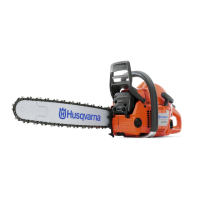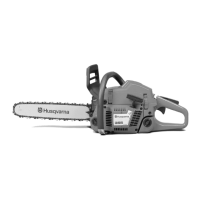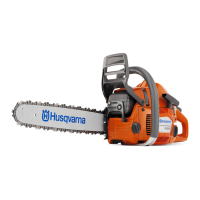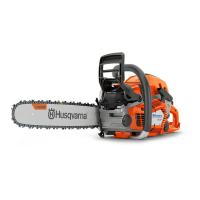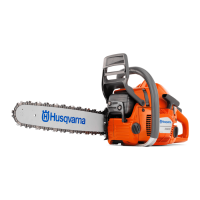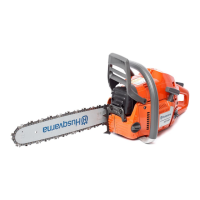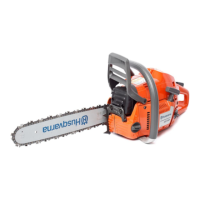Do you have a question about the Husqvarna 359/G 359 E-tech and is the answer not in the manual?
Explains symbols used on the machine for identification and operation.
Details symbols found within the operator's manual for guidance.
A welcome message and introduction to the Husqvarna product.
Identifies and labels the various parts of the chain saw.
Essential checks and initial steps before operating a new chain saw for the first time.
Crucial safety advice and guidelines for safe operation and maintenance.
Emphasizes using common sense, proper PPE, and machine safety features.
Explains the function of safety equipment like the chain brake.
Details on how the chain brake works and its role in preventing kickback.
Information on the throttle lockout function and safe starting procedures.
Techniques for avoiding kickback and maintaining control of the saw.
Explains the function of the chain catcher, right hand guard, and vibration damping system.
Guidance on choosing and maintaining cutting equipment for safety.
Information on the muffler's role and spark arrestor screen requirements.
Details on selecting cutting equipment designed to reduce kickback.
Information on guide bar types and saw chain construction.
Instructions for sharpening cutting teeth and adjusting the depth gauge.
Step-by-step guide on sharpening cutting teeth with proper tools.
Guidance on adjusting the depth gauge and tensioning the saw chain.
Detailed steps for properly tensioning the saw chain.
Instructions for lubricating the chain and checking oil flow.
Proper methods for lubricating the chain, bar, and sprocket.
How to check for wear on the chain, bar, and drive sprocket.
Maintenance for chain drive sprockets and needle bearings.
Tips for bar longevity and final safety checks before operation.
Step-by-step guide on installing the guide bar and saw chain.
Information on gasoline, two-stroke oil, mixing ratios, and environmental fuels.
Details on selecting and using chain oil for optimal performance.
Safe practices for refueling the chain saw and handling fuel.
Guidelines for safely transporting and storing the chain saw.
Step-by-step instructions for starting a cold engine, including choke use.
Procedures for starting a warm engine and using the decompression valve.
Proper methods for starting and stopping the chain saw engine.
Essential checks to perform on the chain saw before starting work.
Basic safety guidelines and precautions for all working situations.
Rules for safe operation, maintaining grip, and avoiding hazards.
Advice on avoiding kickback and proper cutting methods.
Fundamental cutting techniques and important safety factors to consider.
Procedures for dealing with jammed cuts and wood tension.
Techniques for limbing branches and cutting logs safely.
Basic principles of tree felling and maintaining a safe working distance.
Planning felling direction, clearing the area, and preparing a retreat path.
How to make directional cuts to control tree fall.
Performing the felling cut and understanding the felling hinge.
Safety advice on handling trees that have fallen badly or are trapped.
Safely cutting tensioned wood and understanding kickback causes.
Detailed explanation of kickback and how to prevent it.
Awareness of kickback risks during limbing and safe work practices.
Techniques for cutting logs into manageable sections.
Overview of general maintenance tasks and the function of the carburetor.
Detailed procedures for adjusting the carburetor, including low-speed jet and idle speed.
Adjusting high-speed jet, checking carburetor correctness, and introducing safety equipment checks.
Inspecting the chain brake band wear and the front hand guard.
Verifying the operation of the brake trigger, throttle lockout, and chain catcher.
Regular checks on the vibration damping units for damage.
Checking the stop switch functionality and muffler condition.
Procedures for starter housing and changing starter cords.
Steps for replacing the starter cord and recoil spring.
Importance of cleaning or replacing the air filter.
Maintenance of the spark plug, bar tip sprocket, and needle bearing.
Adjusting the automatic chain oil pump.
Maintaining the cooling system and the air intake cleaning system.
Measures for operating the saw in cold and snowy conditions.
Specific covers and plugs for winter use and temperature limits.
Information on heated handle operation and electric carburetor heating.
Details on engine displacement, bore, fuel capacity, and oil pump capacity.
Technical data for guide bars, saw chains, and drive sprockets.
Lists recommended bar and chain combinations for kickback reduction.
Information on file gauges and sharpening parameters for different chains.
Outlines owner and manufacturer responsibilities, warranty coverage, and claim procedures.
Lists the emission control parts covered under the warranty.
Clarifies the owner's responsibility for performing required maintenance.
General safety rules for chain saw users, including kickback and handling precautions.
Covers one-handed operation, fatigue, fuel handling, and general operation safety.
| Engine Type | 2-stroke |
|---|---|
| Weight (excl. cutting equipment) | 5.5 kg |
| Displacement | 59 cm³ |
| Bar Length | 13-20 inches |
| Chain Pitch | 3/8 inch |
| Chain Gauge | 0.058 in |
| Fuel Tank Volume | 0.68 l |
| Oil Tank Volume | 0.38 l |


